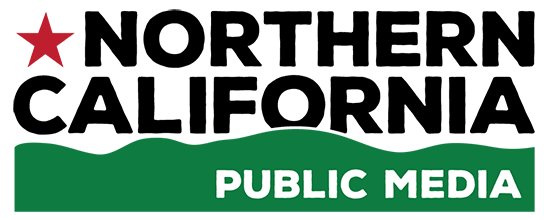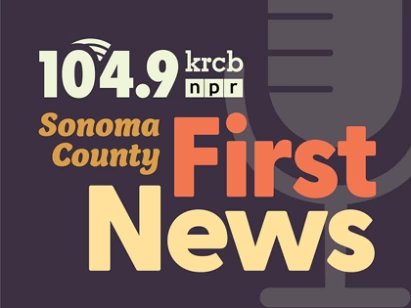 photo credit: Noah Abrams/KRCB
photo credit: Noah Abrams/KRCBCA State Parks environmental scientist Naftali Moed stands below a large oak near
Fern Lake on the former SDC property.
It’s a sunny Thursday morning in Glen Ellen.
The dirt trails crisscrossing the Sonoma Mountain hillsides are muddy and soft after recent rains.
Walking with me through the freshly worked underbrush: Naftali Moed and Joe Plaugher.
Moed is an environmental scientist with California State Parks, Plaugher a coordinator with Sonoma Land Trust.
The area we’re walking through was, until just a few weeks ago, part of the sprawling Sonoma Developmental Center, or SDC, property.
At the start of this year, some 650 acres of the nearly 1000-acre SDC property changed hands; coming under the control of California State Parks.
With the SDC slated for a major redevelopment, the transfer is the culmination of a years-long push to protect the property's open space and forest land from development during the residential redesign.
So what exactly is happening to the property now?
Stewardship work has been pretty minimal in recent years.
Moed said groundskeepers mostly focused on maintaining trails for foot access, but now with the transfer complete, the chainsaws are whirring and the underbrush is getting a needed thinning.
"The reason all this was able to happen so quickly is because of the Sonoma Valley Wildlands Collaborative, which is the partnership of six different conservation organizations that's collectively come together in the wake of the 2017 fires," Moed said.
The Sonoma Valley Wildlands Collaborative consists of Sonoma Land Trust, Sonoma County Ag & Open Space, County Regional Parks, California State Parks, Audubon Canyon Ranch, and the Sonoma Mountain Ranch Preservation Foundation.
Moed noted, "the nimbleness of that collaborative is the reason we were able to get in here and get this work done right now before we enter into a period where most of this work is significantly limited due to Northern spotted owl nesting and then migratory bird nesting."
The land transfer was announced on January 4th, and Plaugher said previous state funding for vegetation management and wildfire risk reduction is being put to use.
"The Land Trust, as a nonprofit, was able to receive the money and then grant it out to [Sonoma County] Regional Parks, [California] State Parks, [Sonoma County] Ag & Open Space, Audobon Canyon Ranch, and we spent some of it ourselves," Plaugher said. "And so we had a little extra funding, kind of expires in June this year, so we were able to grant about a hundred thousand dollars for this project."
A particular target of the work, Moed said, is clearing invasive broom species.
"That's gonna be a many years endeavor," Moed said. "The seed bank for broom can live in ideal settings like over 70 years. The public will see us working on broom in some areas and not in others, and that is gonna be the reflection of strategic decisions we've made to build off of existing broom control work we were doing."
Identifiable by their distinct yellow flowers; French, Spanish, and Scotch broom plants can easily catch fire when dry in the summertime, crowd out competitors, and fix nitrogen, changing local soil composition away from conditions which native plants are evolved for.
Moed said California State Parks and SDC staff have been trying to strategically control broom populations in the area on and off for some years, but Moed said, as with all land management and stewardship work, there is some picking and choosing to be done.
 photo credit: Noah Abrams/KRCB
photo credit: Noah Abrams/KRCBAn invasive broom plant pulled from near Fern Lake on the former Sonoma Developmental Center
property in Glen Ellen, CA.
"We're not just gonna try and blitz through the whole property and pull every broom plant because we don't currently have the capacity to maintain that investment," Moed said. "And that's, that's sort of one of our tenants at [California] State Parks is trying not to pick on projects that will be unmaintainable."
With the work taking on different forms - chainsaw crews, pulling broom, clearing trails - Moed said there will be a noticeable imprint to start.
"The starkest impact more often than not is going to be immediately on the road and trail corridors," Moed said. "Which is how most visitors to this place are gonna experience the landscape."
But Moed said disturbance of the landscape is natural.
"Most of California was adapted to some form of disturbance," Moed said. "Whether it was massive herds of grazing undulates, whether it was more frequent fires, whether it was the flooding that would come in the winter when there was not a dam upstream capturing all that water."
And not just natural, but a good thing too, Moed said.
"Many of our sensitive plant and animal species, in some cases are sensitive because of that lack of those historic disturbances that they've co-evolved with for millennia," Moed said. "In time I think a lot of people start to see exactly that different species of of flowers coming in along the roads and all sorts of things."
All the area needs Moed said, is a little time.
"If we're doing a good job at natural resource stewardship, it's gonna be hard for most people to tell that works occurred here," Moed said. "So come back later this Spring or next year and most of the places we've done this work, you would have a hard time understanding or intuiting anything had happened without taking a really close look."
Another benefit from the recent stewardship effort: fire safety.
The Sonoma Mountain area has been mostly spared from the catastrophic fires of the last seven years. But it's also been deprived of regular low intensity fire over the last hundred years.
Plaugher said bringing fire back to the area, despite the fright, is a must.
"Yeah, ultimately the safest, most fire safe landscape you could have is like a concrete parking lot," Plaugher said. "And that's not really a beneficial to all these systems."
Moed and Plaugher both say the focus now is on keeping the area healthy and restoring natural processes and systems to the landscape - landscape which helps connect wildlife all the way from Point Reyes Seashore to Snow Mountain in Lake County.

 Live Radio
Live Radio




